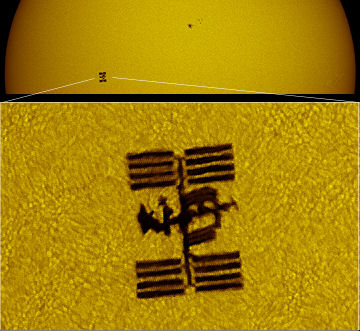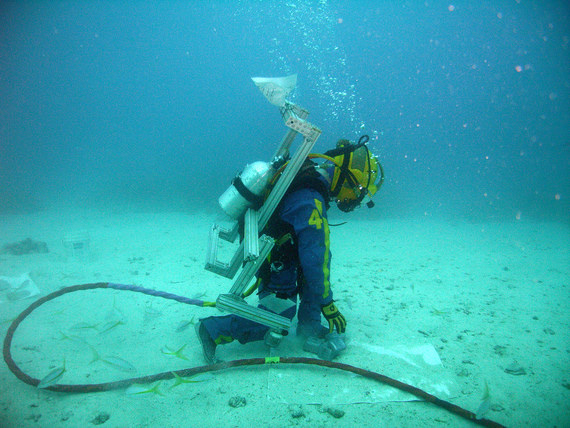Satellite Images Show Oil Slick on the Move
Towards Florida, Possibly East Coast of US

A satellite image from the Moderate Resolution
Imaging Spectroradiometer (MODIS) on NASA’s Terra satellite on May 17,
2010, showing a long ribbon of oil stretched far to the southeast.
Credit: NASA NASA image by Jeff Schmaltz, MODIS Rapid Response Team.
Confirming
some of the worst fears about the Deepwater Horizon oil spill in the
Gulf of Mexico, satellite images now
show part of the oil slick has entered the Loop Current, a powerful
conveyor belt-like current that flows clockwise around the Gulf of
Mexico towards Florida. The Loop Current joins the Gulf Stream — the
northern hemisphere’s most important ocean-current system — and the oil
could enter this system and be carried up to the US East Coast.
Click to continue…
BIG
MYSTERY: In a surprising
development that
has transformed the appearance of the solar system's
largest
planet, one of Jupiter's two main cloud belts has
completely
disappeared. Get the full
story from Science@NASA.
ALIEN
BEAUTY: Multiwavelength images of
the sun
beamed to Earth by NASA's Solar
Dynamics Observatory (SDO) have a beauty that
can only
be described as ... alien. We've never seen the sun
quite
like this before. Consider the following picture
taken just
hours ago by SDO's Atmospheric Imaging Assembly:
The image is a composite of three
extreme ultraviolet
wavelengths: 211 Å (false-color red) 193 Å (green)
and 171
Å (blue), each tracing a different gas temperature
ranging
from 1 to more than 2 million degrees K. Highlights
of today's
sun include an enormous magnetic filament, a coronal
hole,
and a new sunspot: labels.
And that's just for starters. The high-resolution
copy of this image shows many more weird and
interesting
things. Go ahead and take a look; it really is your
star.
AMAZING
TRANSIT: Yesterday (May 22nd) in
Switzerland,
Thierry Legault photographed the International Space
Station
(ISS) and space shuttle Atlantis passing directly in
front
of the sun. The docked spacecraft were framed by
"solar
fire" as they raced by new sunspot 1072:

View
the full-disk transit
"I have never had such good seeing conditions and
this
image surpasses any transit image I've done
before," says Legault. "The sunspot area is
also very sharp." He recorded the split-second
transit
using a solar-filtered 6" refracting telescope.
NASA's shuttle program is coming to an end later
this year,
and Atlantis is making her final scheduled visit to
the ISS.
For this reason, the STS-132 mission
patch shows Atlantis heading into the sunset.
There is,
however, a possibility that Atlantis
might fly again. If so, make that sunset a solar
transit.
~~~~~~~~~~~~~~~~~~~~~~~~~~~~~~~~~~~~~~~~~
Astronomy
Without A Telescope – Stellar Quakes and Glitches
 The upper crust of a neutron star is thought to be
The upper crust of a neutron star is thought to be composed of crystallized iron, may have centimeter high mountains and
experiences occasional ‘star quakes’ which may proceed what is
technically known as a glitch. These glitches and the
subsequent post-glitch recovery period may offer some insight
into the nature and behavior of the superfluid core of neutron stars. Click to continue…
Finding NEEMO
Helps NASA Prepare for the Future
Talking with
the astronauts living in
the NEEMO habitat – NASA's Extreme Environment Mission Operations – is a
bit like talking with Darth Vader; there's a regular hiss of air intake
and outflow in the background. But the ever-present pastel blue hue in
the webcam feed lets you know these astronauts aren't in space. They are living
and working in an underwater habitat, 20 meters (70 feet) under the
ocean, just off the coast of Key Largo, Florida. What are NASA
astronauts doing under the sea?
"This is the closest thing to spaceflight I've ever
had in all my NASA training," astronaut Tom Marshburn told Universe Today in the midst of
his 14-day stay in NEEMO. "It is very real. Our lives are completely
dependent on our habitat, we have to follow checklists and procedures to
be safe, we have to watch out for each other, we're in a tight confined
space and doing real work that will help future space missions. So, in
all ways it is much like spaceflight, including having a great view out
the window."
Except in space, there wouldn't be a giant grouper
peering through the portal.
Click to continue…
Picture
Gallery: STS-132, Atlantis' Last Mission
Is this
Atlantis' last mission to space? STS-132 is the
last scheduled flight for space shuttle Atlantis,
and it remains to be seen whether any additional shuttle flights will
be added. But the imagery from this mission is incredibly rich with
wonderful images of the orbiter. So, while previous shuttle mission
galleries we have here on Universe Today normally
feature images from the EVAs, this gallery will mainly showcase images
of Atlantis. And there are some really great photos — not sure
whether the astronauts/photographers
are consciously focusing on the shuttle or these images are just
marvelously serendipitous. We'll do a second gallery as more images
come in from the later part of the mission. Enjoy!
Click to continue…
New Weekly Sun Fix:
SDO's Pick of the Week
Images and
data are starting to roll in from the Solar Dynamics
Observatory, and the images are nothing short of stunning. So, the SDO
website has started a couple of new image gallery features, which will
provide a "best of" weekly fix without overloading your Sun senses (and no
sunscreen needed!) The first one is Pick of the Week. The image above is the first "pick" and what a pick it is! This SDO
close-up shows a filament and active
region on the Sun, taken in
extreme UV light on May 18, 2010. It shows a dark and elongated
filament hovering above the Sun’s surface, with bright regions beneath
it. The filaments are cooler
clouds of gas that are suspended by tenuous magnetic fields that are
often unstable and commonly erupt. This one is
estimated to be at least 60 Earth diameters long
(about 805,000 km, or 500,000 miles). Wowza!
Click
here to see a super-huge full disk image.
See below for
another new SDO feature, Hot Shots.
Click to continue…
Mars Rovers Set
Surface Longevity Record
Congrats to the
science and engineering teams for the Mars Exploration Rover
program! Today, (Thursday May 20) the Opportunity rover
marked an historic milestone: it has now passed the duration record set
by NASA's Viking 1 Lander of six years and 116 days operating on the surface of Mars.
The celebration was tempered just a bit because Oppy may be the longest
lasting mission on Mars, or it may be second to its twin, Spirit.
Spirit has not communicated with Earth since March 22,
succumbing to the cold and decreased power from its solar panels. If
Spirit awakens from hibernation and resumes communication, then she will
attain the Martian surface longevity record.
Click to continue…
Does the Moon Rotate?
Written by Fraser Cain
The
Moon is familiar; it
always looks the same. We know that the Earth rotates, that's
why the Sun, Moon and stars seem to move
through the sky every day. But does the Moon rotate? And if
the Moon rotates, why do we alway see the same side – it never seems to
change.
Well, the Moon does rotate. In fact, the Moon takes 27.3 days
to turn once on its axis. But the Moon also takes 27.3 days to complete
one orbit around the Earth.
Because the Moon's rotation time is exactly the same amount of time it
takes to complete an orbit, it always presents the same face to the
Earth, and one face away.
Because it only presents one face to the
Earth, astronomers say that the Moon is tidally locked to the Earth.
Although the Moon looks like a perfectly smooth ball, it has slight
differences in the shape of its gravity field. A long time ago, the Moon
did rotate. But each time it turned, the Earth's gravity tugged
at it, slowing down its rotation until it only presented one face to
the Earth. At that point, the Moon was tidally locked, and from our
perspective, it doesn't seem to rotate.
Many other moons in the Solar System are also
tidally locked to their planet. In fact, most
of Jupiter's large moons
are tidally locked.
So, to answer the question: does the Moon rotate?
The Moon rotates once every 27.3 days; the same amount of time that it
takes to go around the Earth, and so it always presents the same face to
the Earth.
Here's an article about the far
side of the Moon; the one we never see from Earth. Here's an
article about the rotation
of the Sun.
Obama
Wants Mission to Asteroid by 2025, Mars by mid-2030's

President
Barack Obama during his speech at Kennedy Space Center on April 15,
2010. Image credit: Alan Walters (awaltersphoto.com) for Universe Today
Speaking
at Kennedy Space Center,
President Barack Obama discussed his plans for NASA which includes
sending astronauts to a nearby
asteroid by 2025 and
going to Mars by the mid-2030's.
"Let me start by being extremely clear," Obama said. "I am 100 per cent
committed to the mission of NASA and its future because broadening our
capabilities in space will continue to serve us in ways we can hardly
imagine." Obama's plan, which includes the $6 billion in additional
funds for NASA over the next five years that was previously announced
and using a scaled-down version of the Orion spacecraft as a
rescue vehicle for the International Space Station.
Also, Obama
committed funds for research now to
build a heavy-lift rocket starting in 2015 — or earlier — to launch
astronauts and payloads to missions beyond the Moon.
Read more…








